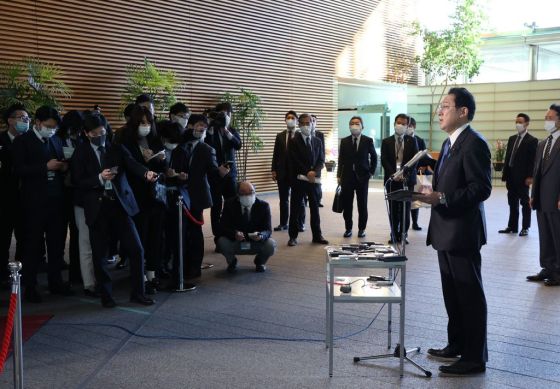SEOUL, South Korea — North Korea fired a suspected ballistic missile into the sea on Wednesday, the South Korean and Japanese militaries said, its first public weapons launch in about two months and a signal that Pyongyang isn’t interested in rejoining denuclearization talks anytime soon and would rather focus on boosting its weapons arsenal.
The latest launch came after North Korean leader Kim Jong Un vowed to further boost his military capability — without disclosing any new policies toward the United States or South Korea— at a high-profile ruling party conference last week.
South Korea’s Joint Chiefs of Staff said in a statement that North Korea fired a suspected ballistic missile toward its eastern waters on Wednesday morning. It said South Korean and U.S. intelligence authorities were trying to analyze more information about the launch.
[time-brightcove not-tgx=”true”]
The Japanese Defense Ministry also detected the North Korean launch, saying the country likely fired a missile.
“We find it truly regrettable that North Korea has continued to fire missiles from last year,” Japanese Prime Minister Fumio Kishida told reporters.
Kishida said other details about the North Korean launch weren’t immediately available, including where the suspected missile landed and whether there had been any damage. He said he ordered officials to confirm the safety of ships and planes in the area where the suspected missile likely flew and fell.
Wednesday’s launch was the first such firing since North Korea tested a series of newly developed weapons between September and November including nuclear-capable missiles that place South Korea and Japan, both key U.S. allies in the region, within striking distance. Some experts said North Korea was applying more pressure on its rivals to accept it as a nuclear power state in the hopes of winning relief from economic sanctions on the country.
The Biden administration has repeatedly said it is open to resuming nuclear diplomacy with North Korea “anywhere and at any time” without preconditions. The North has so far rebuffed such overtures, saying U.S. hostility remains unchanged.

Outgoing South Korean President Moon Jae-in said in his New Year’s address Tuesday that he would continue to seek ways to restore ties with North Korea and promote peace on the Korean Peninsula until his single five-year term ends in May. He has recently pushed for a political, symbolic declaration to end the 1950-53 Korean War as a way to reduce animosities.
U.S.-led diplomacy aimed at convincing North Korea to abandon its nuclear program collapsed in 2019 due to wrangling over how much sanctions relief should be given to the North in return for dismantling its main nuclear complex, a limited denuclearization step. Kim has since threatened to enlarge his nuclear arsenal, though his country’s economy has suffered major setbacks due to the COVID-19 pandemic, persistent U.S.-led sanctions and his own mismanagement.
“Rather than expressing willingness for denuclearization talks or interest in an end-of-war declaration, North Korea is signaling that neither the omicron variant nor domestic food shortages will stop its aggressive missile development,” said Leif-Eric Easley, a professor at Ewha University in Seoul.
Kim Dong-yub, a professor at the University of North Korean Studies in Seoul, said that North Korea might have tested a developmental hypersonic missile or a nuclear-capable KN-23 missile with a highly maneuverable and lower-trajectory flight. He said North Korea would likely move forward with its military build-up plans.
More from TIME
During last week’s plenary meeting of the Central Committee of the ruling Workers’ Party, Kim repeated his vows to boost his country’s military capacity and ordered the production of more powerful, sophisticated weapons systems. State media reports on the meeting said North Korea set forth “tactical directions” for North Korea’s external relations including with South Korea, but didn’t elaborate. It made no mention of the United States.
Last month, Kim marked 10 years in power. Since assuming control after his father and longtime ruler Kim Jong Il’s death in December 2011, Kim Jong Un has established absolute power at home and staged an unusually large number of weapons tests as part of efforts to build nuclear-tipped missiles capable of reaching the American mainland.
During Kim’s 10-year rule, North Korea has performed 62 rounds of ballistic missile tests, compared with nine rounds during his grandfather and state founder Kim Il Sung’s 46-year rule, and 22 rounds during Kim Jong Il’s 17-year rule, according to South Korean and U.S. figures. Four of the North’s six nuclear tests and its three intercontinental ballistic missile launches all occurred under Kim Jong Un’s rule.
—Associated Press Writer Yuri Kageyama in Tokyo contributed to this report
